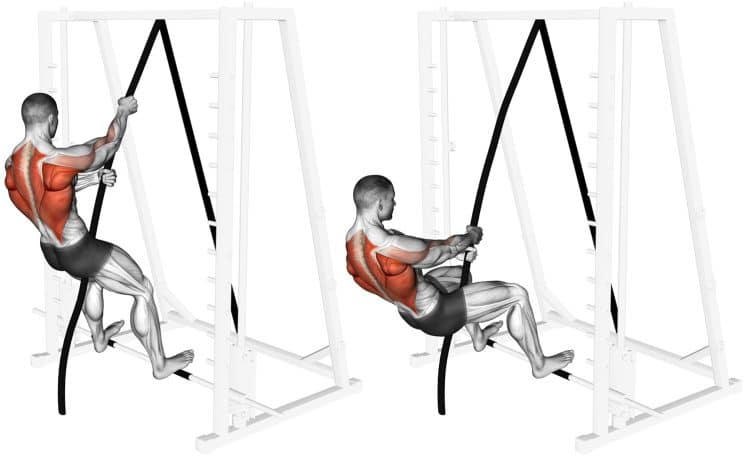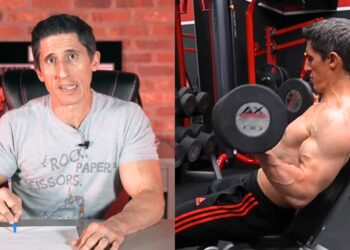Rows and pull-ups getting a little redundant? If so, the London Bridge should definitely be on your radar. A powerful bodyweight back and grip builder, this exercise steers away from conventional resistance training and challenges your fitness and mental fortitude in a fun yet effective way.
In this guide, you learn about proper exercise execution, benefits, effective variations, muscles worked, and more.
How To Do The London Bridge
The London bridge requires upper body strength and a decently strong grip but other than that, it’s a straightforward exercise. Below we’ve included step-by-step instructions and form tips to ensure you perform the London bridge safely and effectively.
To do this exercise, you’ll need a rope and an anchor point such as a squat rack, stall bars/Swedish ladder, or similar equipment to attach it to. Make sure to secure the rope a few feet above your head as shown in the video example below.
Exercise Instructions
- Grab the top part of the rope with both hands by placing one above the other.
- Stand with your feet roughly hip-width apart at the base of the rope and lean back while maintaining a slight bend in your elbows. This is your starting position.
- Keeping your knees slightly bent, slowly lower yourself down toward the floor by moving your hands down on the rope.
- Pull yourself back up to a standing position by moving your hands up the rope. As you reach up to grab the rope, rotate your torso and extend forward to stretch the lats and replicate a single arm row. That’s one rep!
- Complete the desired number of reps to complete your first set.
Here’s a great video example of how to perform the London bridge.
London Bridge Tips
- Bend your knees to make the exercise easier.
- Fully extend your legs to make the exercise more difficult.
- Move your feet forward or place them up onto the anchor (e.g., stall bars) to really increase the difficulty of the London bridge.
- Treat the movement like a row rather than a pull-up. That means get some torso rotation in there to activate the lats and focus on the contraction.
- Maintain a rigid core and straight line from your head to your knees. Do not arch your back.
Progressions
To do the London bridge, you must possess the ability to pull and lower yourself up and down using a rope. While we do recommend that you have sufficient upper body pulling strength before attempting this exercise, we’ve included a video that demonstrates progressions to help you build and develop your pulling ability.
London Bridge Benefits
Let’s talk about why you should include the London bridge in your training.
Level Up Your Fitness: Join our 💪 strong community in Fitness Volt Newsletter. Get daily inspiration, expert-backed workouts, nutrition tips, the latest in strength sports, and the support you need to reach your goals. Subscribe for free!
Build Your Pulling Muscles
The London bridge is primarily a back focused exercise, however, it’s just as beneficial for developing your biceps and forearm muscles which are secondary in all pulling movements. Incorporating rope pulls in your back training workouts allows you to hit the posterior chain a little differently.
Functional Strength
Squatting and pressing lots of weight is the best way to build lifting strength which also has carryover to other exercises and activities. But pulling yourself up using a rope creates a different challenge, plus it’s a great way to improve your grip strength.
If you do CrossFit or are involved in any athletics, this may be a good tool to have in your functional training focused workouts.
Learn more about functional strength training here.
Burn More Calories
The more difficult an exercise, the more calories you can burn as your body requires more energy to perform the task. You want to really challenge yourself? Try moving your body up and down using a rope over and over again while your grip is being tested to the max!
As you get better at it, speed up the tempo to burn even more calories.
Do Something Different
While some people can do the same routine several times per week for years, others need more excitement and variety in their training. Not to mention, humans typically like to do fun and challenging activities such as climbing a rope.
London Bridge Variations
The London bridge is an effective back exercise but these are two variations for more advanced exercisers.
Double Rope
For this variation, attach two ropes to your anchor and alternate sliding your hands down the rope until you are close to the ground. Pull yourself up the rope one side at a time.
Full Rope Climb
If you’ve developed a python-like grip and can pull your entire body up off the ground, then it only makes sense that you shoot for the ceiling with a full rope climb. Of course, you must have access to a dedicated setup which may mean joining a CrossFit gym. You should also learn proper climbing technique which is not covered in this guide.
How To Include The London Bridge In Your Workouts
As with any exercise, how you include the London bridge in your workouts will depend on your preferences, goals and level of training experience. It’s not a conventional back-building movement, and therefore, you must keep this in mind when programming it into your workout routine.
Level Up Your Fitness: Join our 💪 strong community in Fitness Volt Newsletter. Get daily inspiration, expert-backed workouts, nutrition tips, the latest in strength sports, and the support you need to reach your goals. Subscribe for free!
For example, while the London bridge can build muscle and strength, and it is a beneficial functional activity, it shouldn’t be the first choice for bodybuilders and strength athletes. Although it can certainly be incorporated effectively.
Sets and reps
- Beginner – 3-5 sets x 3-5 reps
- Intermediate/advanced – 3-5 sets x 10+ reps
A good place to start with the London bridge is two to three sets of three to five reps as suggested in the video example. As you become more advanced and get stronger, increase it to three to five sets and up to ten reps or more.
London Bridge Muscles Worked
The London bridge is a powerful upper body exercise that works several muscles. Learn about each one and its function below.

Infraspinatus
Grouped with the rotator cuff muscles, infraspinatus shares a common role in supporting the stability and fluid operation and function of the ball and socket shoulder joint. It also contributes to external rotation of the shoulder joint, scaption, and lateral rotation of the humerus.
Latissimus Dorsi
Appearing like butterfly wings when well developed, the latissimus dorsi or lats is the largest muscle in the upper body covering parts of the upper and lower back. All pulling movements work the lat muscles including pull-ups, rows, and similar actions. Working with the teres major and pectoralis major, lats adduct and medially rotate the humerus.
Teres Major and minor
Teres major is a back muscle that medially rotates and adducts the arm and stabilizes the shoulder joint. But it’s not a rotator cuff muscle like the teres minor, one of the muscles that stabilizes the glenohumeral (shoulder) joint.
Trapezius Lower Fibers
The trapezius are a three-sectioned group of muscle fibers including the lower, middle and upper traps. Your lower traps help to pull your scapula down but they also help the upper fibers to elevate the shoulder blades.
Trapezius Middle and Upper Fibers
The middle traps seated between the upper and lower trap fibers can pull the shoulder blades back. Your upper trap fibers elevate and upwardly rotate the scapula and also function to extend the neck. London bridges indirectly train the trapezius muscles.
Brachialis
Most people think the biceps and triceps make up all of the upper arm mass. And while they create majority of upper arm mass, the brachialis is a less talked about arm muscle located deep to the outer biceps area. It crosses the elbow joint and produces flexion of the elbow joint.
Brachioradialis
London bridges are a great forearm workout too, torching the brachioradialis muscles located in the lateral portion of the forearm. It’s twists the forearms so that the palms face either up or down and it can help to flex the elbow joint.
Deltoid Posterior
The shoulder muscles on the backside of the body above the shoulder blades, deltoids posterior adduct the scapula and extend the arms back behind the body like during a barbell bent over row or even a pull-up.
Core
Forming the trunk area, the abdominal core muscles help maintain a strong posture and straight torso preventing energy leaks and lack of efficiency during pulling.
Pectoralis Major clavicular Head
Forming the upper fibers of the chest, pectoralis sternal head or major chest muscle is located on the upper portion of the chest near the clavicle area. These fibers are involved in overhead arm movement.
Build Your Pulling Strength With The London Bridge
If you’ve gotten bored of your current back routine, the London bridge is the perfect exercise to spice things up again. You can include it alongside your other upper posterior chain movements or use it to develop an iron grip but it does have its place in a functional muscle and strength training program.
We hope this complete guide was a helpful resource in helping you to best incorporate the London bridge in your fitness regime.
Interested in measuring your progress? Check out our strength standards for Pull Ups, Chin Ups, Squat, and more.








